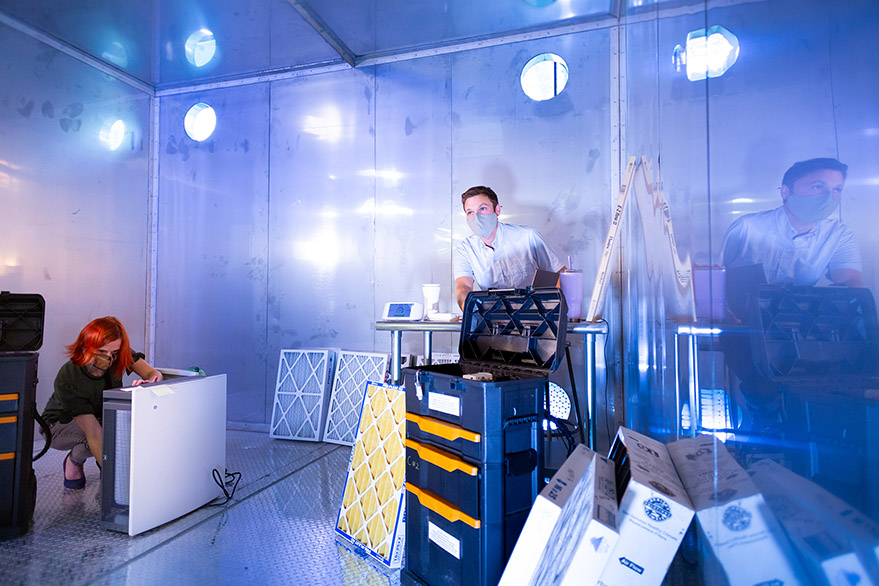Air cleaner testing
Recent wildfire events in the U.S. and the increasing recognition of the potential for aerosol transmission of COVID-19 in poorly ventilated indoor environments has amplified the importance of improving indoor air quality (IAQ) in buildings, especially for workplaces and schools seeking to reduce infectious disease risk and minimize exposures to hazardous conditions.
This increased attention has led to unprecedented levels of interest and investment in indoor air cleaning technologies. The marketplace for indoor air cleaning technologies has become inundated with an array of technologies to meet the demand, including high-efficiency fibrous-media filters, disinfectant misters, and a variety of electronic air cleaners such as ultraviolet germicidal irradiation (UVGI) lights, ionizers, plasma generators, hydroxyl radical generators, extreme heat inactivation units, and more. Workplaces including offices, schools, restaurants, manufacturing facilities, and many more have made substantial investments in air cleaning technologies in efforts to protect workers and other occupants.
However, the efficacy and safety of many emerging technologies remains largely unproven. Test standards to evaluate their efficacy and their potential for adverse effects such as chemical byproduct formation lag far behind their abundance in the marketplace. Instead, most devices have been tested only in commercial laboratories, funded by product manufacturers. Their test reports provide little insight on potential byproduct formation and frequently lack sufficient details to extrapolate reported efficacy results to installations in real buildings. Moreover, no test standards to date adequately or realistically capture the complexities of pollutant removal and potential for byproduct formation. There are no federal agencies who oversee or regulate testing on these emerging devices, despite their potential impacts (either positive or negative) on occupant health.
To fill some of these gaps, the Built Environment Research Group has been independently evaluating the efficacy and potential for adverse consequences (e.g., byproduct formation) of both existing and emerging air cleaning technologies, including stand-alone (portable) and in-duct devices. In collaboration with colleagues at Colorado State University and Portland State University, we are advancing the development and application of test methods for evaluating air cleaning technologies in the lab and in the field. Most of our testing has centered around our large chamber facility on IIT’s campus.
We have the capabilities to measure the following parameters for particulate matter (0.01-10 µm), ozone, nitrogen oxides (NOx), total volatile organic compounds (TVOCs), and speciated VOCs using our controlled test chamber facility:
- Clean air delivery rates (CADR)
- Single-pass removal efficiency
- Byproduct formation rates
- Effectiveness in reducing or generating constituents at steady-state conditions
We are also working to build out testing capacity for evaluating the viability of aerosolized surrogate microorganisms for those air cleaning technologies that target microbial inactivation.
Portable and in-duct air cleaning technologies that we have tested or plan to test include:
- Fibrous media particulate air cleaners (e.g., MERV-rated, HEPA, HEPA-type)
- Electronic air cleaners (e.g., ionizers, plasma generators, UV, PCO)
- Devices utilizing combinations of each of the above
Contact Brent Stephens if you are interested in supporting these efforts or having specific devices tested using our matrix of performance metrics.
A brief summary of reports and publications to date are provided below:
- February 2021 report measuring the efficacy/CADR (for particulate matter, ozone, and TVOCs) and the potential for chemical byproduct formation (e.g., O3 and NOx) of several portable air cleaners from a sample of convenience
- March 2021 paper evaluating a commercially available in-duct bipolar ionization device for pollutant removal and potential chemical byproduct formation
- March 2021 report measuring the efficacy/CADR for particulate matter for a custom box fan and MERV 12/13 filter combination
- July 2021 report measuring the CADR for particulate matter for a version of the ‘Corsi-Rosenthal’ box fan and MERV 10/11 filter combination
- August 2021 report measuring the efficacy/CADR (for particulate matter and ozone) and the potential for chemical byproduct formation (e.g., O3 and NOx) of an Intellipure Compact Air Purifier
- August 2021 report measuring the efficacy/CADR (for particulate matter) and ion production from a Blueair 211+ air purifier
- Updated results for Blueair 211+ after repeated testing in October 2021
- September 2021 report measuring the CADR for particulate matter for a version of the ‘Corsi-Rosenthal’ box fan and MERV 13 filters
- October 2021 testing of a WINIX 5500-2 air cleaner with and without PlasmaWave(R) technology enabled

